Solo Time!
by ANN Managing Editor Rob Finfrock
When I last left off, my instructor and I were
grounded in Ocala, FL due to weather... giving me my first taste of
an unscheduled stopover due to conditions completely beyond my
control. As with most other experiences during my training so far,
I viewed it as a valuable lesson; better to be on the ground,
wishing you were in the sky, than the other way around.
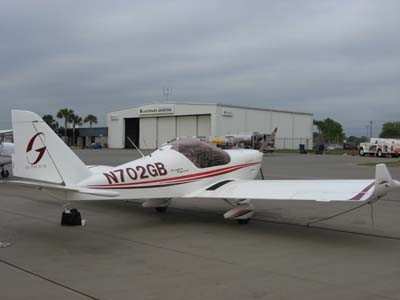
That was my attitude Sunday evening, anyway. When I awoke Monday
morning to find Ocala socked in with fog, and the forecast showing
little sign of improving until much later in the day... I briefly
wondered whether we could have, in fact, made it as far as Palatka
last evening. Were the clouds REALLY that low?
I had another concern, as well. One of the advantages of working
with Aero-News is I can do my job pretty much anywhere, so long as
there's web access. Sure enough, the Comfort Inn had free Internet
access... but my trusty Dell Inspiron had chosen the night before
to die a whirring death, after close to three years of traveling
from Palm Springs to Arlington, from Albuquerque to Oshkosh.
I'd usually have no problem whatsoever with calling Jim Campbell
up, and saying "sorry, can't work -- you need to take the day!" but
this was March 31. The next day was April Fools Day... and well,
you know what the ANN staff does for THAT day. I had to get
somewhere I could work.
By noon, the clouds were still clinging within 500 feet of
ground level, and I had a tough choice to make. It was obvious that
Jim Crone, my instructor, and I couldn't fly the rest of the way
home any time soon. But I did have to get back to Green Cove
Springs to work... which pretty much left just one option.
Fortunately, the gang at Landmark Aviation was able to round up
a rental car for us, and by 1 pm Jim and I were slogging our way
down Florida backroads in a Rent-A-Jetta, heading due northeast,
figuring we'd make the return trip the next morning to retrieve the
plane.
We arrived back at Haller at 3:30. As I got down to the business
of fabricating tall tales of aviation for ANN's April 1st Edition
(for the record, the idea for
"goWest" was born somewhere west of
Interlachen) Jim dialed up the AWOS at Ocala... which, of course,
now reported 2,000-foot ceilings, and light winds. As we'd driven
north on 17, Jim and I had each commented on how the clouds
appeared to be lifting.
"I think I can make it," Jim said. "It's only going to get
better."
So -- trooper that he is -- Jim was soon headed back southwest
towards Ocala, to retrieve our trusty Polish-made aerial chariot. I
regretted I couldn't go, of course, but I did have to work. (I
figured Jim was also entitled to some air time by himself, without
having to worry about a hamfisted student mucking things up.)
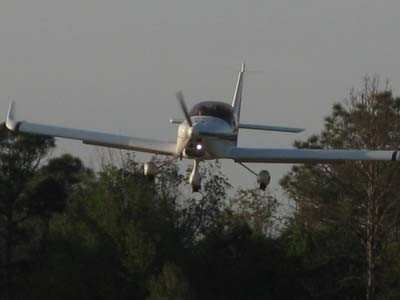
Jim landed just after 7:30 at Haller. "That was a great flight!"
he told me, adding he'd flown over Travolta's place at Jumbolair,
and had seen the tail of his 707 sticking out the covered parking
area.
*****
With the Gobosh (and Jim) safely back at base, we could get down
to business once again... and by "business" I of course mean
finally being able to boot my instructor unceremoniously out of the
plane. (Since I liked him, I figured we could do this on the
ground.) In all seriousness, Jim and I both agreed I could have
soloed Saturday in Punta Gorda, had I not started feeling a little
green around the gills.
Tuesday, April 1, presented the near-perfect chance for me to
finally reach the solo milestone in the Gobosh. The previous day's
rainy weather had cleared out overnight, leaving clear skies with
only a few puffy, high clouds, and moderate temperatures. When Jim
and I took off from Haller that morning, I knew it was only a
matter of time.
After 1.1 hours of dual instruction -- mostly checkride prep,
including practicing the accelerated- and-cross-controlled- stalls
we'd planned to do over Punta Gorda -- Jim and I landed at Palatka,
and refueled. We then taxied over to the FBO, and shut down. I
assumed the next time the Gobosh's Rotax powerplant fired up, it
would be with me, and only me, in the cockpit.
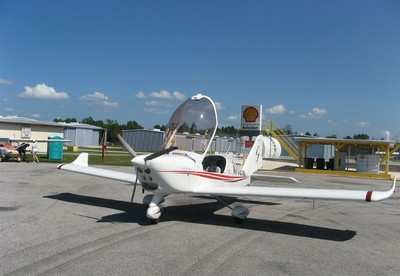
And I was right. With no ceremony, Jim took my logbook "to jot
some notes down" while I grabbed a bottled water. After a few
minutes of scribbling his endorsement, Jim handed me my logbook,
and my marching orders. "Take her up into the practice area, do
some turns and slow flight, then do your three landings when you
get back." He then grinned. "I'm taking a nap."
I walked out to the plane with a mix of excitement, and only a
little nervousness... but not really about the prospect of soloing.
Just before we'd shut down, I'd noted the Skydive Palatka plane was
taking off, carrying a load of jumpers. We'd been in the FBO about
10 minutes -- just about enough time for the first wave to be ready
to go.

Confirmation of that thinking came almost the moment I switched
the avionics master on, after starting the engine. "Skydiver in one
minute!" the pilot said forcefully over the CTAF. "Palatka traffic,
be advised we'll have one jumper over the airport in one
minute."
I finished the post-start checklist, then turned my eyes skyward
from the ramp. The route to the active runway -- 27 today, with a
good breeze from the southwest -- goes right past the drop zone
target on the field, so I figured I'd wait to taxi out until the
parachutist was safely on the ground. With the engine idling and
brakes firmly applied, I watched through the Gobosh's canopy as the
skydiver floated overhead, down to Earth. From my perspective, he
appeared to land directly in the center of the drop zone.
I took this as a good omen, as I throttled up and headed for the
runway. After my run-up, I called out on the CTAF, and took the
runway. The improvement to the Gobosh's takeoff performance without
Jim onboard was negligible, though I was mindful to pitch up even
more cautiously on rotation than I had earlier.
Once on downwind, I marvelled just a bit at the progress I'd
made in a week; it had only been that long since I hadn't been able
to taxi in a straight line, nevermind takeoff... and well,
look at me now!
I climbed out of the pattern on downwind, just as the skydiving
plane called out the imminent drop of a second wave of jumpers; it
looked like Jim's advice to head to the practice area first would
be a good idea. I leveled off at 2,000 feet just as I reached the
shore of the St. John's River, and took a second to look below, at
boaters on the water.

They may think they're having fun down there, I
thought. But they should really try this sometime.
Once in the unofficial practice area, about 10 miles from 28J, I
cleared the area around the plane and delved first into turns.
Picking out an "island" on the river as my reference point, I
started my maneuvering.
No surprise, I had no problem with 30-degree 360s to either
side, while maintaining altitude and airspeed... and while my
45-degree turns to the left were also acceptable, my attempts to
duplicate the same results to the right were met by oscillations in
altitude. It's not uncommon for pilots in the left seat of a
side-by-side aircraft to climb on right turns... but I'd performed
them fine with Jim onboard, and now I was having problems with this
-- and, apparently, only this -- by myself. No matter what I did, I
couldn't hold my altitude.
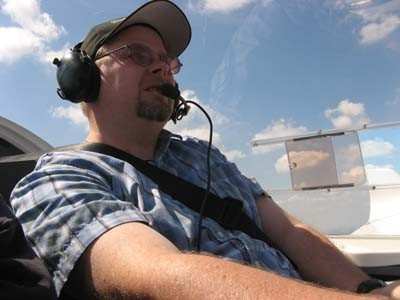
OK, if at first you don't succeed... come back to it
later, I decided. I leveled the wings on a northerly course,
and configured the Gobosh for slow flight, with a target speed of
60 knots.
It was during this exercise the only two ergonomic foibles in
the Gobosh cockpit -- things I'd have done differently, if only
they'd asked -- became most evident. Admittedly, one of those
miscues -- the placement of the trim wheel, on the center console
directly abeam my gluteal region -- probably wouldn't be as much of
an issue for a thinner pilot, but because of my bulk, reaching the
trim wheel required an odd contortion of my right arm.
Fortunately, it only takes VERY minor adjustments of the wheel
to trim out the Gobosh; I learned quickly that if I turned the
wheel more than a hairsbreadth, I'd probably overtrimmed.
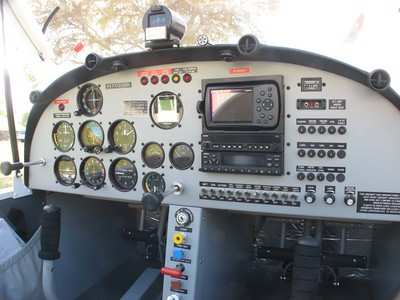
The second item, though, I never fully came to terms with. The
700S has a conventional push-pull throttle lever, like many a
Cessna single before it. The plane actually has two throttle
levers: one in the center, and one on the far left, ostensibly so a
pilot may use his or her left hand for power inputs. I never
touched it -- I always flew with my left hand and controlled the
throttle, flaps and trim with my right, just as I had since my
first days of training, although I'm right handed.
The push-pull throttle works well enough in principle... but
early on, both Jim and I noted a tendency for the throttle to
creep forward, towards full open, unless the friction ring was
tightened almost to full resistance. That, in turn, made it
difficult to move the lever... not an issue so much when in-flight,
but it could be problematic if you needed to go to full
throttle -- or full idle -- on short final.
Jim and I eventually found the "sweet spot" between throttle
movement and resistance, and in most modes of flight it became
second nature... but now, as I worked the Gobosh's throttle to find
just the right amount of power to hold my target airspeed of 60, it
again occurred to me there's a better way of doing this already out
there.
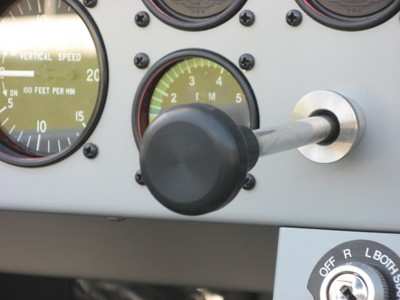
The SportStar I flew last year had a vernier-type throttle,
similar to what's found on Beech Bonanzas. To make substantial
throttle inputs, a pushbutton at the tip of the lever releases the
lever, so the throttle may be operated in the conventional
push-pull fashion... but for minor power changes, the throttle
lever also twists, allowing for incremental changes. Flying the
Gobosh, I realized how much I missed this arrangement.
Would it stop me from purchasing a 700S, or refusing one if
offered? Of course not -- and as I already said, once the "sweet
spot" in resistance was found, the push-pull system was perfectly
workable. But the vernier-style arrangement seems a better match
for LSA equipped with the peaky Rotax; with an available power band
of over 2,000 rpm, the additional control and precision the vernier
throttle provides seems to me to be an asset.
After 10 minutes or so of puttering around, and over, the river,
it was time to head back to Palatka. After checking the skies
around me, I made a 270-degree steep right turn to head back to the
airport; I held altitude a little better this time around, but
still busted the 100-foot barrier as I leveled the wings again.
Dang-nabbit!

Approaching 28J, I heard two other planes in the pattern -- one
Skyhawk, and a Cirrus. Runway 27 was still the active runway, and
my approach made a midfield entry on left downwind the best course
of action, although it would also require a dogleg to the south. Ah
well; I really wasn't in a hurry.
Slotting in behind the Cirrus and ahead of the Skyhawk, I
was soon turning base just as the low-wing single crossed the
numbers. I had ample time to configure the plane for landing; there
was a shallow crosswind from the left on final, but a slight crab
kept me on track.
My first landing -- make that my first two -- was a bouncer.
Damn it, flat again! Instead of powering up to save it, I
elected to go-around, to collect my bearings. C'mon,
Finfrock!
Another lap of the pattern, and my time had once again come. Fly
60 on final, cross the threshold at 55, I repeated to myself. Once
over the numbers, I gradually brought the nose up... and up... and
up... until the stall horn wailed, just as I was about two inches
off the ground.
The Gobosh landed softly on its mains -- first the left wheel,
then the right -- its nose proud in the air.
Awright! Do that again... and was anyone
watching? Throttle in, half-flaps, and I was off again. My
third landing also brought on the stall horn, although it wasn't
quite a smooth a touchdown as the second one had been.
As I taxied back to the FBO (gee, funny how I'm no longer
having issues with the plane's castering nosewheel...) I
pondered what had gone wrong on the first landing... and, what had
gone right.
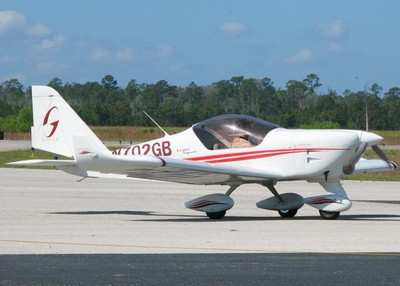
Even though I'd landed flat and fast, the plane's nose remained
rod-straight down the centerline; my previous issues with keeping
the nose lined-up hadn't resurfaced here. The plane was
still intact, so was the pilot, and two-thirds of those landings
were to checkride standards otherwise.
All in all... not a bad way to spend April 1. No foolin'.
(Special thanks to Hernan Enriquez, for use of his photo of
me taxiing in at 28J -- Rob)
Coming Next Thursday: Affirmation
 Classic Aero-TV: The Switchblade Flying Car FLIES!
Classic Aero-TV: The Switchblade Flying Car FLIES! ANN FAQ: Q&A 101
ANN FAQ: Q&A 101 ANN's Daily Aero-Term (04.12.24): Discrete Code
ANN's Daily Aero-Term (04.12.24): Discrete Code ANN's Daily Aero-Term (04.13.24): Beyond Visual Line Of Sight (BVLOS)
ANN's Daily Aero-Term (04.13.24): Beyond Visual Line Of Sight (BVLOS) ANN's Daily Aero-Linx (04.13.24)
ANN's Daily Aero-Linx (04.13.24)












